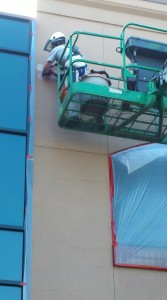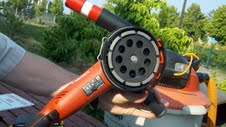Thu 12 Jul 2012
Airborne Silica in Stucco?
Posted by admin under Air Monitoring, Drywall, Engineering Controls, HEPA, Personal Protective Equip (PPE), Respirators, Silica, Stucco
Comments Off on Airborne Silica in Stucco?
Living in the NW, stucco is not as prevalent, compared to other areas of the US, as a building material. I finally got the opportunity to perform air monitoring for silica during stucco crack repair. From what the contractor explained, only the top layer of stucco (1/8 inch) is removed. He claimed the top layer is mostly an acrylic. The employee was wearing a 1/2 face tight fitting respirator with P100 (HEPA) cartridges. In addition, engineering controls were used. Â  The contractor had a grinder with a shroud and vacuum to remove the dust. This would not be considered a worse-case sampling scenario. From conversations with the plasterer-employees onsite, grinding is usually “VERY dusty”.
The contractor had a grinder with a shroud and vacuum to remove the dust. This would not be considered a worse-case sampling scenario. From conversations with the plasterer-employees onsite, grinding is usually “VERY dusty”.
Sampling performed only for the duration of the grinding (3 hours). Conclusion?: We did not find any detectable levels of silica or respirable dust.
Please don’t use this sampling as the only information on how to proceed for your project. However, here are my observations:
- If acrylic material is the top 1/4 inch, you may not impact silica (or have any airborne).
- Airborne dust was very well controlled by grinder with shroud & vacuum (see pic below).
- Assume you will have dust until you can observe (or prove) otherwise. Wear a respirator.
- Perception is huge. If there is a big dust cloud coming from your grinder—even if there’s no silica… the observers don’t know the difference, and, well,…you know the story.

No Responses to “ Airborne Silica in Stucco? ”
Sorry, comments for this entry are closed at this time.